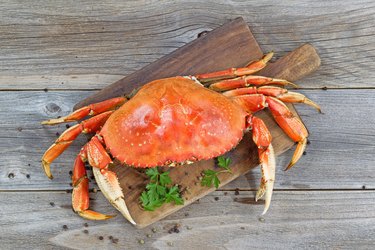
Who doesn't enjoy tucking into delicious sweet crab meat? Whether you crack it from the claws or use ready prepared lump meat, you'll usually be reheating crab rather thank cooking the live shellfish. So should you reheat crab in the oven, reheat crab in the microwave or do it some other way?
Nutritious crab is a particularly good source of the mineral zinc, which the Office of Dietary Supplements explains is important for the immune system, for wound healing and for the sense of taste and smell. One king crab leg supplies 10.2 milligrams zinc according to the USDA — that's nearly all of the daily value of 11 milligrams.
Video of the Day
Video of the Day
No Heat Required!
It's worth mentioning that crab doesn't actually need to be reheated to be enjoyed: Crab legs and crab claws can simply be thawed (if frozen) or taken out of the refrigerator and served chilled with melted butter and lemon wedges.
Similarly, many uses of cooked crab meat don't require it to be reheated. For example, you can use cooked crab straight from the fridge in crab cocktails (with lettuce and cocktail sauce), in crab salads or to make dips or pate. Several recipes also require the chilled cooked meat to be added straight to a dish close to the end of cooking.
If you prefer your crab hot, there are various ways you can achieve this. But remember you are only warming it through — be careful not to overheat it, as this will adversely affect the texture and taste. When you are reheating crab, a little care is needed to help keep the meat juicy and tender.
Read more: The 9 Safest Seafood Options
Moist Heat Is Best
It's not ideal to reheat crab in the oven, as it may dry out. For crab still in the shell, moist heat is better. In an interview with First for Women, HelloFresh chef Claire Sidoti suggests a simple boiling method, ideal for reheating crab legs and claws:
- Fill a large pot about two-thirds full with water, adding a pinch of salt.
- Add the crab legs to the boiling water.
- Boil for four to five minutes (while cooking, use tongs to adjust the crab legs as needed to ensure full coverage in the water).
- Remove the crab legs from the boiling water and serve.
Steaming is another excellent method for reheating crab legs — in a steamer basket over boiling water they'll typically be ready in five to six minutes. You can also reheat crab in the oven in a way that mimics steaming. To do this, simply reheat in a covered ovenproof dish that you've added half an inch of water to.
Sidoti also recommends a method to reheat crab in the microwave:
- Wrap the crab legs with dill sprigs.
- Cover each bundle with damp paper towels, then with cling wrap.
- Microwave each bundle of crab legs for about two minutes.
- Take the bundles out of the microwave, remove the cling wrap and paper towels, and serve immediately.
Read more: Disadvantages With Cooking in the Microwave
Food Safety First
Whether you prefer to reheat crab in the microwave or to to boil or steam, it's important to remember to observe some simple food safety rules around the storage, preparation and serving of the shellfish.
According to the FoodSafety'gov's FoodKeeper app, cooked crab meat should be eaten within one to three days when kept in the refrigerator and cooked crabs legs within two to four days. Frozen cooked crab meat keeps for two to four months and frozen crab legs for nine to 12 months.
After adding cooked chilled crab meat to hot dishes (for example, stirring through hot pasta or risotto), always eat straight away and don't leave the dish hanging around at a lukewarm temperature. According to the USDA Food Safety and Inspection Service, temperatures between 40 and 140 degrees Fahrenheit can cause very rapid bacterial growth.
Along similar lines, any leftover cooked crab that has been left on a counter top at room temperature should be discarded within two hours.
- Office of Dietary Supplements: "Zinc"
- USDA: "Crustaceans, Crab, Alaska King, Cooked, Moist Heat"
- National Institutes of Health: "Dietary Supplement Label Database: Labeling Daily Values"
- First for Women: "How to Reheat Crab Legs so None of That Deliciousness Goes to Waste"
- FoodSafety.gov: "Food Safety App"
- USDA Food Safety and Inspection Service: "'Danger Zone' (40 F - 140 F)"